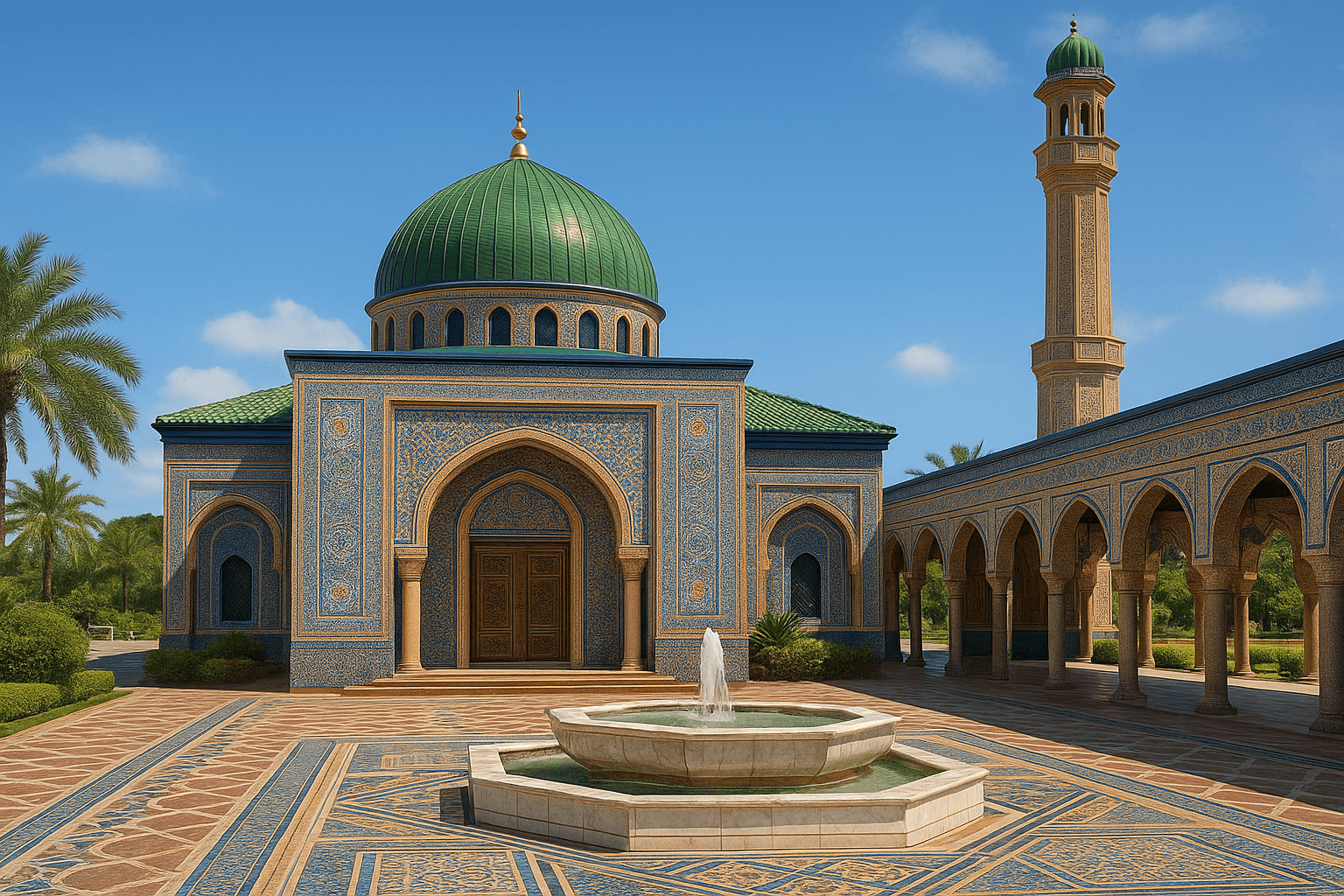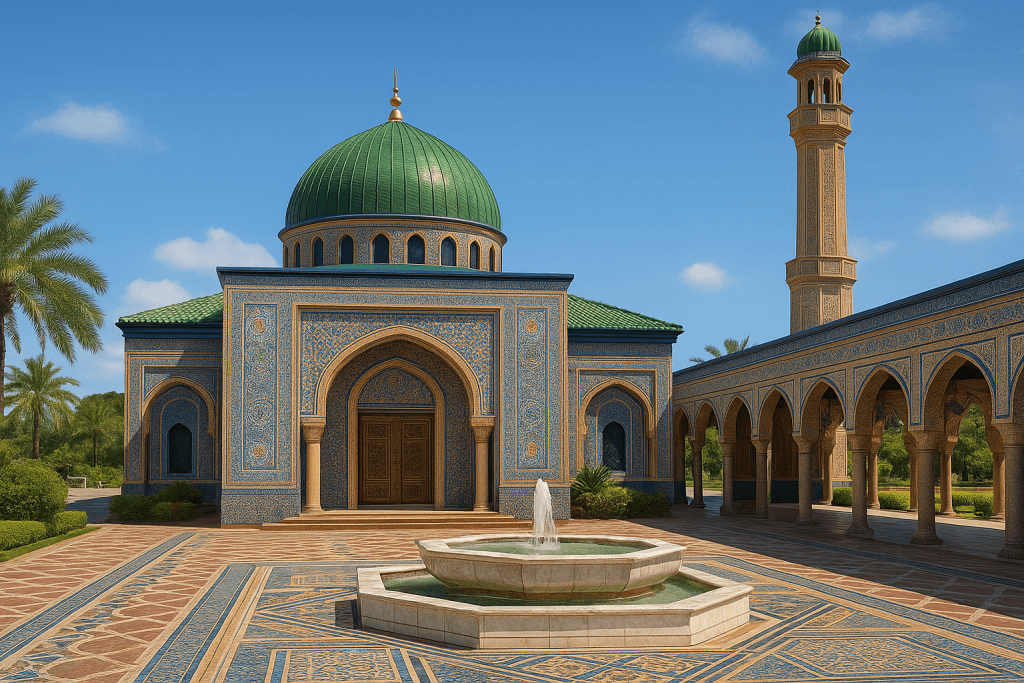Among the remarkable landmarks that define the cultural and architectural identity of Brunei, the Ash Shaliheen Mosque – Moroccan Architectural Influence in Brunei stands as one of the most enchanting. This mosque represents a unique fusion of Islamic devotion and Moroccan artistry, creating an architectural masterpiece that draws visitors from across the globe. Built under the patronage of Sultan Haji Hassanal Bolkiah, the mosque was designed to showcase the elegance of Moroccan design within the spiritual and cultural context of Brunei.
The mosque not only serves as a place of worship but also as a symbol of cultural exchange, bridging the Islamic traditions of North Africa with the Malay identity of Brunei Darussalam. From the intricate mosaics and elaborate zellij tilework to the grand arches and carved wooden ceilings, every detail reflects centuries of Moroccan craftsmanship.
This article will take you through the history, architecture, cultural significance, and spiritual atmosphere of the Ash Shaliheen Mosque – Moroccan Architectural Influence in Brunei, providing a comprehensive understanding of why it is regarded as one of Brunei’s architectural gems.

The Origins and Vision Behind the Mosque
The idea to construct the Ash Shaliheen Mosque – Moroccan Architectural Influence in Brunei stemmed from Sultan Hassanal Bolkiah’s admiration for Islamic architecture beyond Southeast Asia. He envisioned a space that could bring the artistry of Morocco into Brunei’s Islamic heritage. This vision was realized through collaboration with Moroccan craftsmen and architects who brought authentic design elements from North Africa.
Completed in 2012, the mosque reflects the Sultan’s commitment to creating an environment of spiritual reflection, cultural appreciation, and architectural magnificence. It is located near the Prime Minister’s Office in Bandar Seri Begawan, symbolizing the link between governance, faith, and cultural identity.
Moroccan Aesthetics in the Heart of Borneo
The defining feature of the Ash Shaliheen Mosque – Moroccan Architectural Influence in Brunei is its Moroccan aesthetic. While most mosques in Brunei follow traditional Malay or Middle Eastern styles, this mosque breaks new ground by incorporating Moroccan artistry, evident in the following design elements:
Zellij tilework: Intricate mosaic patterns cover the floors and walls, a hallmark of Moroccan craftsmanship.
Horseshoe arches: Distinctive archways frame entrances and windows, adding grandeur to the mosque.
Muqarnas ceilings: Three-dimensional plasterwork creates geometric vaulting effects that dazzle worshippers.
Hand-carved cedar wood: Imported from Morocco, the wooden doors and ceilings showcase extraordinary artisanal detail.
Courtyard fountain: Inspired by Moroccan riads, the fountain symbolizes purification before prayer.
These features immerse visitors in the ambiance of North Africa, making the mosque not just a house of prayer but also an artistic journey.
A Place of Worship and Reflection
At its core, the Ash Shaliheen Mosque – Moroccan Architectural Influence in Brunei is a sacred space for Islamic devotion. Its prayer hall accommodates hundreds of worshippers, providing an atmosphere of serenity enhanced by natural light streaming through stained glass windows.
The mosque is especially significant during Friday prayers, Islamic festivals, and Ramadan, when it becomes a center of spiritual gathering for the community. Worshippers often remark on the peaceful ambiance created by the blend of Moroccan design and Bruneian culture.
Architectural Details and Symbolism
Every corner of the Ash Shaliheen Mosque – Moroccan Architectural Influence in Brunei embodies symbolism and meaning:
Geometric motifs symbolize the infinite nature of Allah, with no beginning or end.
Arabesque patterns represent the unity of faith, culture, and divine order.
Color choices such as green, blue, and gold reflect prosperity, spirituality, and light.
Minaret design merges Moroccan influence with Bruneian proportions, standing as a beacon of faith in Bandar Seri Begawan.
The architecture is not merely decorative; it conveys the principles of Islam through artistry.
Cultural Significance in Brunei
The construction of the Ash Shaliheen Mosque – Moroccan Architectural Influence in Brunei goes beyond aesthetics. It represents Brunei’s openness to learning from other Islamic traditions while preserving its national identity. By incorporating Moroccan architecture, Brunei highlights the unity of the Muslim world, where diverse expressions of faith and art coexist harmoniously.
For local citizens, the mosque strengthens their cultural pride. For international visitors, it serves as a symbol of Brunei’s role in global Islamic heritage.
Comparison with Other Mosques in Brunei
Brunei is home to magnificent mosques, such as the Omar Ali Saifuddien Mosque and the Jame’ Asr Hassanil Bolkiah Mosque, each reflecting different aspects of Islamic architecture.
Omar Ali Saifuddien Mosque: Renowned for its Italian marble and golden dome, representing Brunei’s fusion of East and West.
Jame’ Asr Hassanil Bolkiah Mosque: Built to commemorate the Sultan’s reign, with 29 golden domes symbolizing the 29th Sultan of Brunei.
Ash Shaliheen Mosque – Moroccan Architectural Influence in Brunei: Stands apart for introducing Moroccan artistry, making it a unique landmark.
This variety underscores Brunei’s rich architectural diversity within its Islamic identity.
Tourist Attraction and Photography Spot
The Ash Shaliheen Mosque – Moroccan Architectural Influence in Brunei has become a favored destination for tourists, researchers, and photographers. Its mosaic details, arches, and landscaped gardens provide perfect subjects for photography. Visitors are captivated by how Moroccan artistry thrives in the tropics of Borneo.
Tour operators often include the mosque in cultural tours of Bandar Seri Begawan, highlighting it as a must-see for those interested in Islamic art and architecture.
Educational and Cultural Exchange
Beyond being a mosque, the Ash Shaliheen Mosque – Moroccan Architectural Influence in Brunei also fosters educational and cultural exchange. Scholars of Islamic art, architecture students, and cultural enthusiasts visit the mosque to study its design. It demonstrates how cross-cultural collaborations enrich local traditions without diluting authenticity.
Spiritual Atmosphere During Festivals
During Ramadan, the Ash Shaliheen Mosque – Moroccan Architectural Influence in Brunei transforms into a hub of spiritual devotion. The taraweeh prayers, Qur’an recitations, and community iftar gatherings infuse the mosque with an atmosphere of unity and reflection. Moroccan lanterns and traditional decor enhance its festive appeal, reminding visitors of the cultural bridges it embodies.
Preservation and Legacy
The preservation of the Ash Shaliheen Mosque – Moroccan Architectural Influence in Brunei is a national priority. Regular restoration ensures that the delicate mosaics and woodwork maintain their original beauty. The mosque’s legacy will endure as a testament to Sultan Hassanal Bolkiah’s vision of blending faith, art, and cultural exchange.
Conclusion
The Ash Shaliheen Mosque – Moroccan Architectural Influence in Brunei is far more than a place of worship. It is a cultural bridge between North Africa and Southeast Asia, a testament to Brunei’s openness to global Islamic artistry, and a living masterpiece that inspires worshippers and visitors alike.
Its Moroccan tilework, carved wooden details, and serene prayer spaces represent the unity of the Muslim world through diversity. As part of Brunei’s architectural heritage, it continues to attract admiration for its ability to harmonize Moroccan elegance with Bruneian spirituality.
Anyone visiting Bandar Seri Begawan should not miss the chance to witness this unique mosque, which remains a jewel of Brunei’s cultural and religious landscape.

